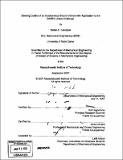Steering control of an autonomous ground vehicle with application to the DARPA Urban Challenge
Author(s)
Campbell, Stefan F. (Stefan Forrest)
DownloadFull printable version (12.02Mb)
Other Contributors
Massachusetts Institute of Technology. Dept. of Mechanical Engineering.
Advisor
Karl Iagnemma and John Leonard.
Terms of use
Metadata
Show full item recordAbstract
Fundamental to the design of an Ackerman steered autonomous ground vehicle is the development of a low-level controller that effectively performs trajectory or path tracking. Though ample literature is available on various methods for controlling ground vehicles, little information is presented on the implementation and tuning of such controllers. Moreover, few sources extend ground vehicle control to driving in reverse. This work presents a novel approach to the implementation of the traditional "pure pursuit" style controller in which a dynamic vehicle model is used to map from the path curvature specified by the pure pursuit algorithm to the vehicle's actual steering angle. Additionally, an analytical methodology using a linear model of straight-line path following is used to tune the pure pursuit look-ahead distance. This pure pursuit controller is then contrasted with a simulation-based controller that uses a kinematic model to predict the vehicle's response to a series of different steering inputs; a performance metric is used to select the best command given these predictions. Successful trajectory control results are presented at speeds up to 22 mph. The second focus of this work is the control of a front-wheel steered vehicle driving in reverse. Novel to this work is the presentation of pure pursuit as a stable solution to this problem. Pure pursuit is then contrasted with the mechanism-based controller that was developed by Patwardhan et al. at the University of California Berkeley. In presenting this controller, a new method employing a linear kinematic vehicle model is used to tune the controller parameters. It is then shown that, under specific conditions, the mechanism-based controller and the pure pursuit controller are identical. Both controllers are then compared with the simulation-based controller adapted for driving in reverse. (cont.) Results are presented at speeds up to 6.7 mph. Results for the implementation of these controllers were collected using a 2006 Land Rover LR3 developed for MIT's entry into the 2007 DARPA Urban Challenge. Results ultimately illustrate the respective strengths and weaknesses of the pure pursuit class of controllers.
Description
Thesis (S.M.)--Massachusetts Institute of Technology, Dept. of Mechanical Engineering, 2007. Includes bibliographical references (p. 156-157).
Date issued
2007Department
Massachusetts Institute of Technology. Department of Mechanical EngineeringPublisher
Massachusetts Institute of Technology
Keywords
Mechanical Engineering.